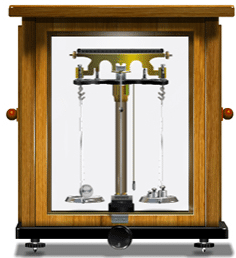Theory & Procedure, Beam Balance | Additional Study Material for NEET PDF Download
Objective
To find the mass of the given body by sensibility method, using a beam balance.
Theory
The beam balance is a device used for the determination of the mass of a body under gravitation.

It consists of a beam supported at the centre by an agate knife edge resting on a support moving inside a vertical pillar. The beam carries a light pointer which moves over a scale. There are two stirrups at the ends of the beam which carries two scale pans of equal masses along with adjusting nuts. These can be adjusted to make the pointer oscillate within the scale when the balance is raised. The balance is mounted on a platform provided with three leveling screws which make the pillar vertical. There is a plumb line which shows whether the pillar is vertical or not. The balance is enclosed in a glass case in order to avoid disturbances due to air.
Correct mass of the body using the beam balance,

Where,
W - Mass in the pan
R0 - Zero resting point
R - Resting point with the body counter-poised with weight W
S - Sensibility of the balance.
The sensibility S, the weight required to shift the resting point by one division is calculated from the equation,
R1 – Resting point with 10 mg in the right pan
Learning outcomes
- Students able to know the working principle of beam balance.
- Students learn about the sensibility of beam balance.
Materials required:
- Beam balance
- Box of weights
- A rectangular wooden block
- Pendulum bob
Procedure:
How does a beam balance work?
The leveling screws at the base are adjusted to make the pillar vertical. The beam is gently raised by turning the handle. If the pointer does not oscillate almost equally on either side of the central division of the scale, adjust the nuts suitably at the ends of the beam.
Before determining the mass of the body one needs to calibrate the beam balance.
1. To find the zero resting point (R0)
The balance is released and the pointer is allowed to oscillate freely. Three or five successive readings (three to the left and two to the right on the scale against which the pointer turns back during oscillations) are taken. These readings are called the turning points. The average turning point on the left and the average turning point on the right are separately calculated. The mean of these averages gives the zero resting point ( R0).
2. To find the sensibility of the balance (S)
For finding the sensibility, 10 mg weight is placed in the right pan and the resting point (R1) is determined as before. Then the sensibility S is calculated using the equation (2) explained in the 'Theory' tab. .
Now let’s find out the mass of the body (M)
The balance is arrested by turning the handle. The given body is placed in the left pan and it is counter balanced by a known mass (W) in the right pan. The resting point (R) is determined. The correct mass of the body can be calculated using the relation (1) explained in the the 'Theory' tab.
Note: The pointer of the beam balance always rests near the pan having less weight.
Simulation Procedure :
For Sensibility Checking
- Release the knob.
- Note three consecutive turning points (three at left and two at right).
- Arrest the knob.
- Click on open door.
- Place 10 mg in the right pan of the balance.
- Click on close door button.
- Now release the knob.
- Note three consecutive turning points(three at left and two at right ).
After sensibility calculation,
- Click on the open door button.
- Click on 10 mg to remove it from the balance.
- Select an object by a single click on bob/wooden block.
- The object would counter balanced by selecting weights given on a single click.
- Click on close door button.
- Release the knob to note the turning points as before.
- Repeat the steps for adding more weights or reduce weights to counter poise the weight in the left pan.
- Click on the show result button to view the result.
- A reset button is also provided to reset the entire the simulation.
Note: The pointer of the Beam balance always rest near the pan having lesser weight.
Observations:
To find the weight of the body
Loads in Pan | Turning Points | Mean Turning Points | Resting Point | |||
Left | Right | Left | Right | Left | Right | |
Nil | Nil | R0= | ||||
Nil | 10 mg | R1= | ||||
GIven Body | W=----g | R= | ||||
Calculations
1. Sensibility, =................................................g / div
2. Correct mass of the body, = ............................g
=………………kg
Result
The mass of the body = ………...............……kg
|
26 videos|312 docs|64 tests
|
FAQs on Theory & Procedure, Beam Balance - Additional Study Material for NEET
| 1. What is a beam balance? |  |
| 2. How does a beam balance work? |  |
| 3. What is the procedure for using a beam balance? |  |
| 4. What are the advantages of using a beam balance? |  |
| 5. What are the limitations of using a beam balance? |  |
















